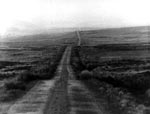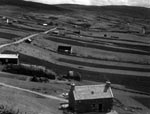






 |
|||||
 |
 |
 |
 |
 |
 |
|
 The Roman Road featured in the opening
sequence of The Face of Scotland (1938).
|
An Ancient NationThe film begins by physically entering Scotland, the camera pans up the road walked by the Roman advance guards to look upon the deserted hills that met their gaze before cutting to shots of Hadrian's Wall: '"Our advance guards were met with a widespread and desolate silence. The hills were deserted and though smoke rose from distant homes not a soul came forth to meet us." So spoke the Romans who marched their long straight roads through England to the Cheviots. They built a wall, it stands there to this day, a confession that here was one land, at least, they were not to conquer.' |
|
The first series of shots are presented as point-of-view shots of those advance guards. In beginning with the legionnaires the film begins with the threat of Scotland's invasion, the penetration of the nation's boundary by an alien other. The rhetoric of this threatened invasion sets up a distinction between moving (modern) travellers, 'the Romans who marched their long straight roads', and a static (ancient) culture, 'not a soul came forth to meet us'. The wall that is built remains as a testimony both to that threat, and to the fact that it was repelled. |
|

One of the scattered settlements featured in the opening
of The Face of Scotland.
|
The use of figurative language in the opening moments of the film is quite
striking; 'widespread and desolate silence', 'hills were deserted', 'not
a soul'. The troping of the narration conjures up bleakness in the way it
signifies a general absence of sound and people. This is given a melancholy,
rather than sinister suggestion by the tone of both the voice and the music.
A further metaphor is employed in the narrator's statement that the wall
signifies 'a confession that here was one land, at least, they were not
to conquer'.
The narration transforms the wall into a monument, something that preserves the memory of an important event. The fact that the wall is no longer equivalent to the geo-political border is irrelevant to its figurative function in the documentary as the national boundary between Scotland and England. Such symbolic boundaries play a central role in the manufacture of national identity, marking the limits of the national space beyond which lie other nations and other cultures. Further, the reminder that the wall 'stands there to this day' creates a physical link between ancient past and contemporary present, a link that the documentary works hard to construct. |

|
|
| Author: Richard Butt | Images are drawn from the SCRAN database. |